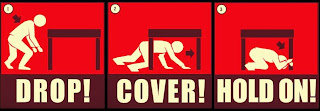This week we are exploring earthquakes and what countries do to prevent/mitigate the hazard. If I want to know something about earthquakes in a place, the first websites I go to are: the USGS Real Time Earthquakes Website or the IRIS monitoring website.
Regarding where quakes are located in the US, this seismicity map below from USGS shows the (obvious, in hot pink) ring of fire portion on the West coast but also a central area in the middle of the plate. I’d like to talk a bit more about this non-obvious one. This area, called the New Madrid Zone was shaken by a M8(!) in 1811. The reason for the activity is a very old intraplate rift placed below the area (see image from http://showme.net).
The San Andreas Fault System is responsible for most of California natural quakes...we had over 50 in the last 24h. The latest swarm of quakes in the Salton Sea has been featured in the news often. Earthquakes up to magnitude 4.6 under the Salton Sea are raising concern that a larger quake could be unleashed on the San Andreas fault. The southernmost section of the fault has not ruptured since about 1680.
So, what can we do about it?; apart from the obvious need for education, I want to focus on the USGS ShakeAlert system, developed for the West coast using some of the existing systems. Today, the technology exists to detect earthquakes, so quickly, that an alert can reach some areas before strong shaking arrives. The purpose of an EEW (Earthquake Early Warning) system is to identify and characterize an earthquake a few seconds after it begins, calculate the likely intensity of ground shaking that will result, and deliver warnings to people and infrastructure in harm’s way. Studies of earthquake early warning methods in California have shown that the warning time would range from a few seconds to a few tens of seconds, depending on the distance to the epicenter of the earthquake.
A few seconds of warning could make all the difference (enough to stop transit/elevators and to drop, cover, hold on).
Being aware of the risk and know what to do when the shaking starts is very important. We know that earthquakes cannot be predicted (I recommend Dr. Jones’ book called the big ones’ if you want more information about that)


Hello Professor Ana,
ReplyDeleteLiving in California, it is good to know that there is an early warning system in place on the west coast. This early warning system, ShakeAlert will give the population those few precious seconds to be alerted and to prepare, to drop, to cover, and to hold on.
I chose the United Kingdom and they have a emergency response and recovery website at Gov.UK , but this is nothing like ShakeAlert, probably because they do not really have any large earthquakes.
Thank you
Tom Bunting
Very good point, Tom. It makes sense the only the countries with real hazard risk have planned mitigation efforts etc.
ReplyDelete